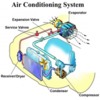Ray
Ron (accobra) is in the A/C business, he'll be a good resource, hopefully he'll contribute to your topic.
I've done a lot of A/C filling and refurb in my life.
To fill an A/C system from scratch you gotta draw it down to a very low vacuum, after it is drawn down (which only takes a few minutes) keep the vacuum pump on it for a couple of hours to boil-off any moisture, then close the valve between the vacuum pump and A/C system, and observe the A/C system pressure (vacuum) for 2 to 24 hours. There should be an accurate vacuum gauge on the system, as part of your refrigeration manifold, which is also hooked to the bottle you plan to fill from. You should be able to observe that the vacuum does not decrease at all over the observation period, indicating there are no air leaks into the system. If the vacuum does drop-off you have some leaks to chase down before you can fill. Repeat this step as often as necessary.
You should have an idea how much refrigerant the system holds, in terms of weight. Its gonna be more than 2 pounds but less than 4 pounds. I can't remember the exact weight for the Pantera, perhaps somebody can help with that info. So you place your refrigerant bottle on a scale, and do an initial fill based on weight while there is still a vacuum on the system. Close the valves and bottle the system up again.
Start the engine, and let it idle until the coolant is at normal operating temp. Then set the engine to idle at 1500 rpm. This is the engine speed (rpm) at which automobiles are operated while filling their A/C systems. This speed is important because it impacts the pressures on the suction and discharge of the A/C compressor.
Place a thermometer in one of the A/C outlets on the dashboard, to monitor the temperature of the cooled air. Roll the windows down and/or open the doors. Set the fan at high speed, set the temp control at maximum cold, and set the air vents for normal operation (as opposed to max A/C or recirculation of air). The A/C compressor clutch should be engaged and the A/C system should be blowing cold air from the vents.
Using the A/C manifold, admit some gas from the refrigerant bottle into the suction of the pump (while the engine is running, idling at 1500 rpm). The system pressures shall spike a bit. Close the manifold valve and allow the system pressures to stabilize. Stabilization will take a minute or two. The pressures should stabilize at a somewhat higher reading, and the temp of the air blowing out of the dash vent should be a bit colder. This indicates the system is low on gas.
You want to repeat this procedure until you reach a point where admitting additional gas does not increase the system pressures or make the air blowing out the dash vent colder. At that point the system is filled, operating at equilibrium, and the receiver tank is beginning to fill with liquid Freon (the excess Freon is condensing). You can often determine the level of Freon in the receiver tank by observing the "frost level" on the outside of the tank. I like to fill the system until the liquid level (frost level) in the receiver tank is about 50%.
The suction pressure of the compressor should be 10 to 20 psi at equilibrium. The discharge pressure and the air temperature shall be dependent upon the ambient air temp and humidity. You hope the discharge air temp will be in the 40 degree F range, and the compressor discharge pressure is between 180 and 240 psi. Old receiver/dryers (plugged with debris), bad expansion valves, or hot days will cause the discharge pressure to run higher. If the compressor discharge pressure reaches 300 psi before the system reaches equilibrium you should shut down the fill procedure and figure out what is wrong.
Regarding using R12 verses using R134a, R12 is a more benign gas. R12 is compatible with mineral oil based compressor oil and typical rubber elastomers. R134a is not. R134a is more corrosive, and is a smaller molecule that leaks more easily. Equipment compatible with 134a shall also be compatible with R12 ... but the opposite is not true. Equipment compatible with R12 is not necessarily compatible with R134a. For instance hoses ... R134a will leak right out between the molecules of the oem rubber A/C system hoses, and it will attack them and turn them into "goo" at the same time. R134a hoses are normally lined with Teflon. The same is true for the material used for the fitting O-rings and the seals and valves within the compressor. Viton, which is used for R12 is not compatible with R134a. The compressor oil is also different for R134a.
If you decide to use R134a, the system will perform better if the expansion valve is replaced with a valve designed for R134a.
Scott Bell converted his Pantera to R134a years ago, he shall be a good resource in that regard.
PANTERA INTERNATIONAL
A DE TOMASO CAR CLUB
Presents the De Tomaso Forums
The On-Line Meeting Place for De Tomaso Owners and Enthusiasts From Around the World
Clicking on the banner will take you to the sponsor's website.


